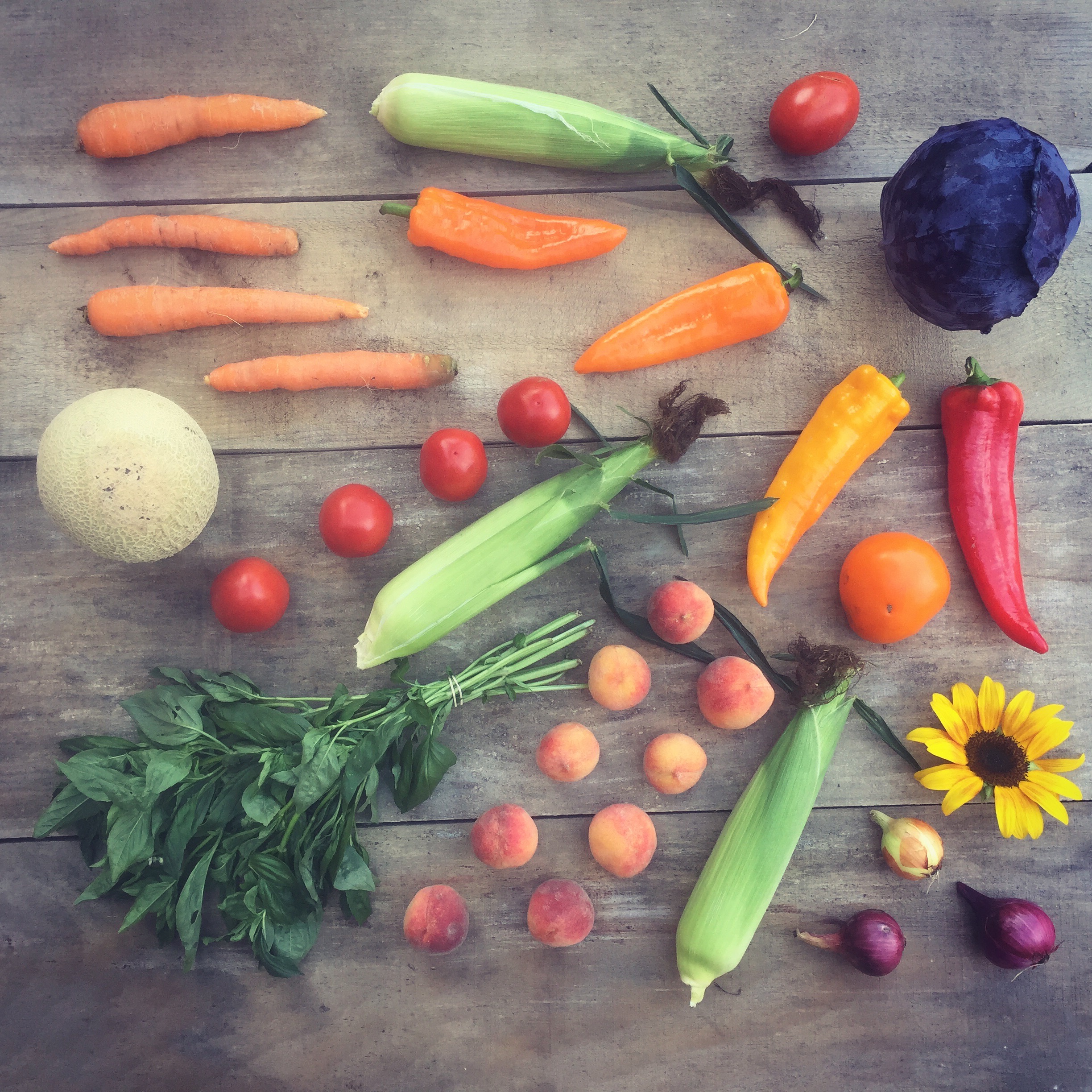Pick List:
So Many Tomatoes (plums and other wise) - Cherry Tomatoes -
Carmen Peppers (3 varieties) - Peaches - Corn - Asian Greens -
Garlic - Red Onion - Carrots - ZINNIAS & SNAP DRAGONS
KITCHEN SHARE: ROASTED CARROT HUMMUS
First a note from the FIELDS:
There is always a week every year that makes us all feel absolute dreamy about the place we live, i think that week is happening as I type- which is a shame because I am inside on a computer (but my kid-o is sleeping so computer work commences). I should be picking cherry tomatoes with the field crew, turning my fingers a funny shade of green, and talking about the weekend. Actually, peace out- I’m gonna go do that.
Alright, returning now back to the computer- all is dark outside so I don’t really feel like I’m missing much- there is too much to do during the precious daylight hours and every day i feel robbed as the light level changes, perhaps you feel the same? I think I wrote last week of the push to put up food for the winter. Even with the burst of warm weather we are having right now, that feels super important. This week my goal is to tackle peaches. I plan to pick and can as much as possible in two nights of work (i can’t be bothered with more than two nights of canning per week- such a mess). So that is the personal end goal for the week- canning peaches along with all the other chores while making sure my tiny human is happy.
How is your winter prep going? FALL CSA sign up is ongoing and with every tiny green leaf that sprouts from the greenhouse (arugula! Asian greens! spinach!) i am already grateful for the food that will come when everything else feels dark and bare.
In other news the concrete got poured for our brand-spanking-new pack house set to be in use of Spring 2018. I am thrilled. More on that later.
TIPS - TRICKS - RECIPES
Author Notes: This is the single most genius thing you can do to a tomato. They’re best and most outrageous when made with ripe Romas or other meaty types, but as Wizenberg points out, slow-roasting will bring out the tomato in even the pale and off-season, if you feel the need. Make a lot. They keep for a week in the fridge, and are just fine in the freezer. Adapted slightly from Orangette and A Homemade Life(Simon & Schuster, 2009). (less) —Genius Recipes
Makes as many tomatoes as you want to cook
Ripe tomatoes, preferably Roma
Olive oil
Sea salt
Ground coriander
Heat the oven to 200° F. Wash the tomatoes, cut out the dry scarred spot from the stem with the tip of a paring knife, and halve the tomatoes lengthwise. Pour a bit of olive oil into a small bowl, dip a pastry brush into it, and brush the tomato halves lightly with oil. Place them, skin side down, on a large baking sheet. Sprinkle them with sea salt and ground coriander—about a pinch of each for every four to six tomato halves.
Bake the tomatoes until they shrink to about 1/3 of their original size but are still soft and juicy, 4 to 6 hours. Remove the baking sheet from the oven, and allow the tomatoes to cool to room temperature. Place them in an airtight container, and store them in the refrigerator.
The following is taken from the blog: http://www.readingmytealeaves.com/2012/10/fall-tomatoes.html, i am including her intro even though it reads like a story that i did not write, it all resonates and feels completetly relatable...
There is a chill in the air but there are still so many tomatoes and you can’t let tomatoes go to waste and so you make sauce. You do not take the skins off, they are so thin anyway and you can’t be bothered.
you add a tablespoon of butter to your simmering tomatoes and then another. The sauce comes out orange. There were just so many colors. You are grateful that the blending of so many colors did not make like your nursery school pictures and turn a muddy purple. You realize that wouldn’t have been so bad either. You think about lycopene and how long the winter is and you are grateful to have an orange tomato sauce now. You take pictures of the sauce after the sun has mostly left the apartment because that is when it is ready and because sometimes life can’t be dictated by picture-taking. You slurp down the sauce on al dente spaghetti and you grin at your husband. you are thankful. times a million.
– – – – – – – –
a sort of recipe:
saute a yellow onion and four cloves of garlic in olive oil until they are golden.
add tomatoes, all cut up and still with their juices.
add a healthy dose of sea salt (i add enough to fill my palm) and the same amount of herbs de provence. think of your friends who are there. allow yourself to get lost in provincial reverie. add a tablespoon of sugar.
let the whole mess simmer for an hour or two, or as long as you need to finish whatever else you’re doing.
turn off the burner and let cool for a minute or five. pulse the sauce in a blender and return it to the pan.
add a heart pad of butter and simmer some more. taste. season. eat.
that is it. purists be damned.

















